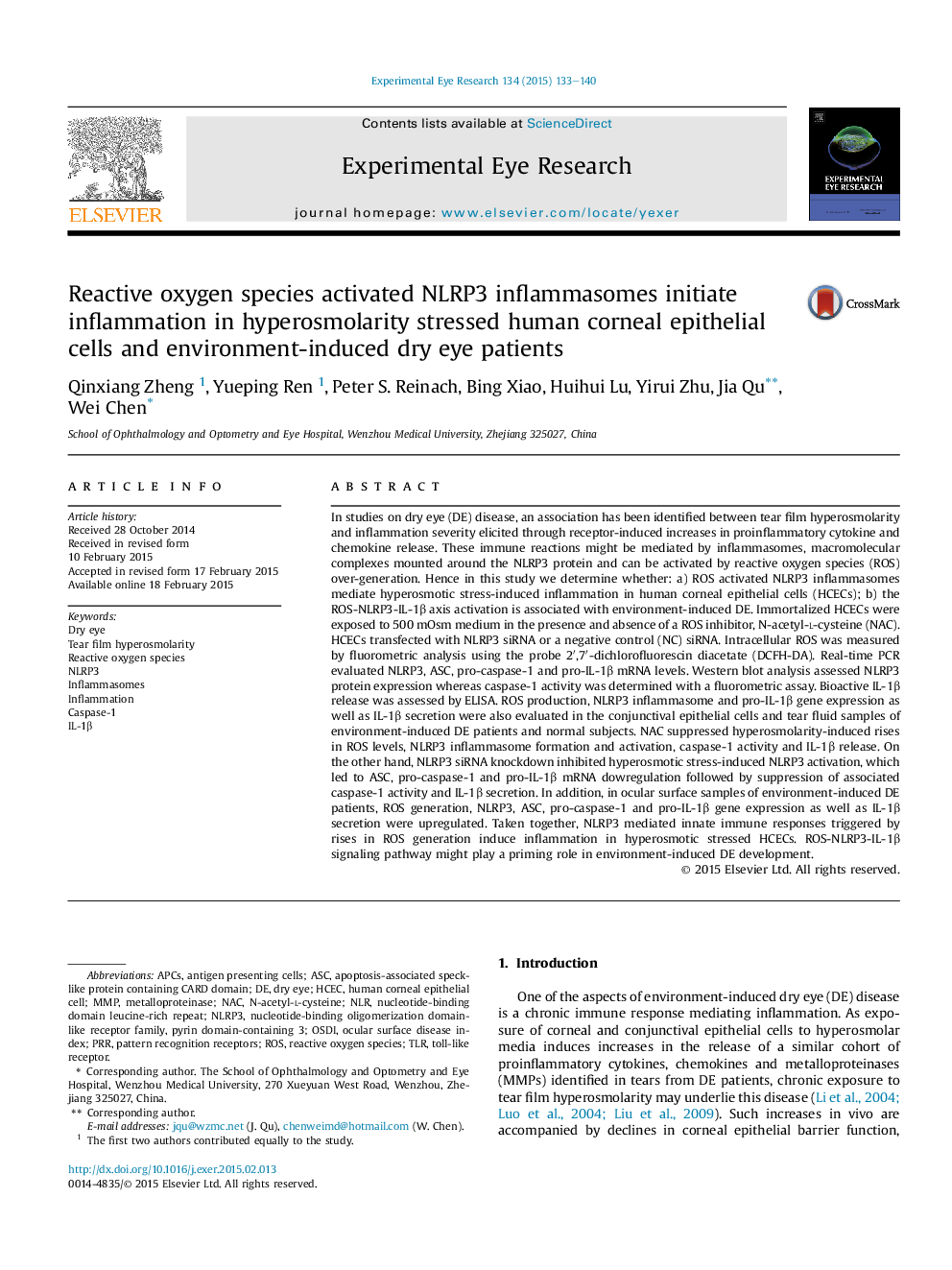| کد مقاله | کد نشریه | سال انتشار | مقاله انگلیسی | نسخه تمام متن |
|---|---|---|---|---|
| 6196605 | 1602588 | 2015 | 8 صفحه PDF | دانلود رایگان |

- Hyperosmolarity activates ROS-NLRP3-IL-1β signaling axis in human corneal epithelial cells.
- NLRP3 inflammasome activation induced increases in IL-1β secretion via caspase-1 activation.
- ROS inhibitor suppressed hyperosmolarity-induced ROS-NLRP3-IL-1β signaling axis activation.
- NLRP3 siRNA knockdown attenuates hyperosmolarity-induced NLRP3 activation and IL-1β release.
- ROS-NLRP3-IL-1β signaling pathway axis is upregulated in environment-induced dry eye patients.
In studies on dry eye (DE) disease, an association has been identified between tear film hyperosmolarity and inflammation severity elicited through receptor-induced increases in proinflammatory cytokine and chemokine release. These immune reactions might be mediated by inflammasomes, macromolecular complexes mounted around the NLRP3 protein and can be activated by reactive oxygen species (ROS) over-generation. Hence in this study we determine whether: a) ROS activated NLRP3 inflammasomes mediate hyperosmotic stress-induced inflammation in human corneal epithelial cells (HCECs); b) the ROS-NLRP3-IL-1β axis activation is associated with environment-induced DE. Immortalized HCECs were exposed to 500 mOsm medium in the presence and absence of a ROS inhibitor, N-acetyl-l-cysteine (NAC). HCECs transfected with NLRP3 siRNA or a negative control (NC) siRNA. Intracellular ROS was measured by fluorometric analysis using the probe 2â²,7â²-dichlorofluorescin diacetate (DCFH-DA). Real-time PCR evaluated NLRP3, ASC, pro-caspase-1 and pro-IL-1β mRNA levels. Western blot analysis assessed NLRP3 protein expression whereas caspase-1 activity was determined with a fluorometric assay. Bioactive IL-1β release was assessed by ELISA. ROS production, NLRP3 inflammasome and pro-IL-1β gene expression as well as IL-1β secretion were also evaluated in the conjunctival epithelial cells and tear fluid samples of environment-induced DE patients and normal subjects. NAC suppressed hyperosmolarity-induced rises in ROS levels, NLRP3 inflammasome formation and activation, caspase-1 activity and IL-1β release. On the other hand, NLRP3 siRNA knockdown inhibited hyperosmotic stress-induced NLRP3 activation, which led to ASC, pro-caspase-1 and pro-IL-1β mRNA dowregulation followed by suppression of associated caspase-1 activity and IL-1β secretion. In addition, in ocular surface samples of environment-induced DE patients, ROS generation, NLRP3, ASC, pro-caspase-1 and pro-IL-1β gene expression as well as IL-1β secretion were upregulated. Taken together, NLRP3 mediated innate immune responses triggered by rises in ROS generation induce inflammation in hyperosmotic stressed HCECs. ROS-NLRP3-IL-1β signaling pathway might play a priming role in environment-induced DE development.
Journal: Experimental Eye Research - Volume 134, May 2015, Pages 133-140